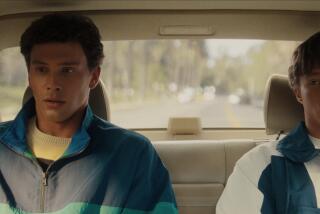The Empire of the Insects
- Share via
Buzzzzzzzz. . . . SPLATTT.
Oh well, you say, it’s just a little insect. A nuisance to be squashed on a counter top or squirted with pesticide. Just a smear of protoplasm, another speck on the biological scrap heap.
But what if--you gasp--what if the tables were turned? What if we were small, and they were big? If we were the bugs and they had the power to squish us?
It could happen. In movies, it’s been going on for 100 years.
“Mimic,” which came out during the summer, featured ghastly humanoid cockroaches that terrorized Manhattan after a hybridizing experiment went terribly wrong.
Infernal insects loom large in “Starship Troopers,” based on the novel by Robert A. Heinlein, which came out last month.
Although the big-bug genre had its golden age in the 1950s, directors have returned repeatedly to insects as stars of fright-inducing films.
When you stop to think about it, the concept defies logic, says monster-movie aficionado Marty Baumann of Arlington, Va.
“The only frightening thing about bugs is that they’re small. They can get into small places to creep you out,” said Baumann, creator of a Web page for monster and B-movies: https://www.bmonster.com. “I don’t know why directors thought it would be twice as scary to make them big. Conversely, a movie with tiny dinosaurs wouldn’t really work.”
Bugs have a long, though mainly low-budget, movie history. One of the first big-screen terrors was a spider that crawled into bed with some poor schmo in “Une nuit terrible,” an 1896 short subject by French film genius Georges Melies.
In the 1950s, they squirmed, invincible, across drive-in screens throughout the land. These hairy, slimy crawlers not only invaded fictional cities, they also crept into the darker crevices of our minds.
Bugs are creepy. But why?
Besides the troubling phallic symbolism of some long-legged insects, their ubiquitousness is discomfiting, says Dr. Carole Lieberman, a Beverly Hills psychiatrist and assistant clinical professor of psychiatry at UCLA.
“We’ve been told that if the Earth is in danger of being overrun by one species or classification, that it would be insects. So that when we see an insect, it’s not just that tiny little bug but what that insect represents, which is the potential to overwhelm us, to blot us out, to overrun us.”
May Berenbaum looks at the big-bug phenomenon from a scientific perspective. As a professor and head of the entomology department at the University of Illinois at Champaign-Urbana, she organized the school’s Insect Fear Film Festival, now entering its 15th season. The festival presents horror movies, backed up by commentary on their scientific authenticity or lack thereof.
Berenbaum says people fear insects for any number of reasons. They can bite, sting or carry infection. They’re hard to keep track of (in your clothing, for example), and they can breed, hidden from view. They’re troublesome to those who demand complete control of their environment.
Maybe most important, she says, “they don’t look like us. There are not enough recognizable landmarks in their faces for people to relate to them.”
The real fear factor in most of these movies is rooted in the concept of science gone awry.
“The whole big-bug thing came out of America’s atomic fears,” said Paul Gaita, a freelance writer and drive-in editor of Video Eyeball magazine, based in Boston. “It was only 10 years after Hiroshima and Nagasaki. . . . Then there were the Alamagordo atomic tests. America was really trying to push atomic energy on its citizens as an effective energy source. But nobody really knew what it could do.”
The first atomic creature film is generally considered to be 1953’s “The Beast From 20,000 Fathoms.” A Ray Bradbury story, it features a dinosaur melted out of the Arctic by an atomic blast. The beast is eventually gunned down on a Coney Island roller coaster by actor Lee Van Cleef.
The daddy of big-bug epics was first screened in 1954. “Them!,” starring James Arness and James Whitmore, is the story of giant ants spawned in the aftermath of atomic testing.
“ ‘Them!’ is the best one,” Baumann says. “But the best one is not necessarily my favorite.”
No. 1 on Baumann’s list is “The Monster That Challenged the World,” about a mammoth caterpillar, born in the Salton Sea, that attacks the lab of a scientist played by Hans Conreid. “It has a fun cast,” Baumann says, adding, “How many movies are set in the Salton Sea?”
As Baumann suggests, “best” and “quality filmmaking” are not necessarily synonymous in this genre.
“The Beginning of the End,” starring Peter Graves, is frequently and affectionately cited by fans as having some of the worst special effects ever. In one scene, giant grasshoppers swarm atop the Wrigley Building in Chicago. Presumably to keep the costs down, director Bert I. Gordon shot real grasshoppers climbing up a postcard of the building. As they reach the top of the card, they fall off.
“Peter Graves is in the building, and you’re supposed to feel afraid for him because they’re coming to get him,” Baumann notes.
“The Deadly Mantis” features a papier-ma^che monster who meets his maker in the Holland Tunnel. As he lays waste to a variety of vehicles, an obvious flaw emerges.
“He smashes this bus, and you can see for a fleeting moment the word ‘Tonka’ stamped on the side of the bus,” Gaita says.
Giant bugs, most agree, were never meant to be taken too seriously. “They were definitely made for the teenage audience, but with tongue planted firmly in cheek,” Gaita says.
Whereas ‘50s directors depended on Fiberglas and even puppets to create their vile, oversize vermin, contemporary directors use computers to manufacture chills. Still, instilling terror is an inexact science.
“I think people have become jaded enough to know when effects have been done on a computer. The suspension of disbelief isn’t as full,” says Gaita, who lives in West Hollywood. “I think that’s what attracts people to ‘50s monster movies--the attempt to look somewhat real. With computers, there’s a coldness to it. It becomes too perfect.”
Baumann, who, as an Internet Web designer, works with computers every day, says that he can spot most computer-generated special effects and that some are only so-so. Animator Ray Harryhausen (“The Seventh Voyage of Sinbad,” “Mysterious Island”) was able to create monsters with real screen presence, he says.
“Unless animators are really, really good with working a personality into the monster, then I’d have to say there’s something scarier about a guy in a suit than animation,” he says.
But, as they say in the movies, there may be no turning back.
“We are getting so realistic now, it’s as if our adult nightmares are coming true,” says Michael Stein, publisher and editor of Filmfax and Outre magazines in Evanston, Ill., and a big fan of ‘50s movies. “We can look back at those sophomoric effects, and they’re fun. But since we know so much more now, we need more to make us scared.”
Despite that, the old big-bug flicks aren’t likely to buzz off into cinematic oblivion because they’re a link to our past.
“They were ever-present on TV when I was growing up,” Baumann says. “For some reason, I was fascinated by the fact that someone would try to pour so much heart and soul and money into trying to make something convincing.
“That’s the part that always fascinated me.”
More to Read
Only good movies
Get the Indie Focus newsletter, Mark Olsen's weekly guide to the world of cinema.
You may occasionally receive promotional content from the Los Angeles Times.










